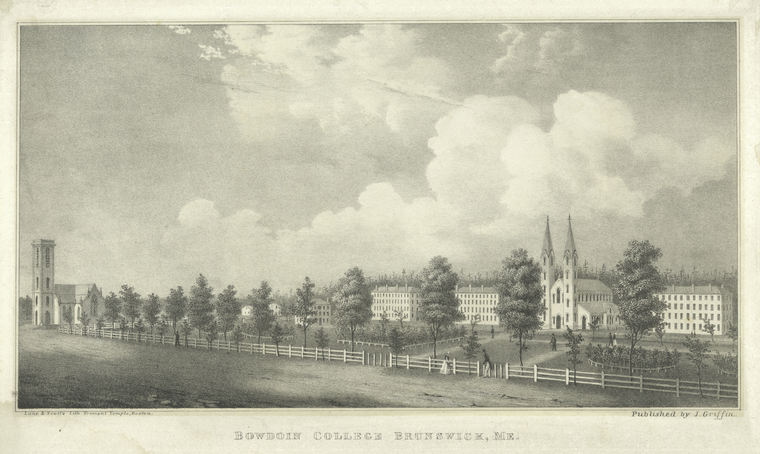Dr. Kaufman carried photocopies of some notes and images of interest. I found the following image from collections at the New York Public Library via Wikimedia Commons that shows sites more as Stowe experienced them.


By Lane & Scott, FitzHugh Lane [Public domain], via Wikimedia Commons
The most easily identified buildings in the lithograph from the left are: First Parrish Church, Massachusetts Hall, Winthrop Hall, Maine Hall, Bowdoin Chapel, and Appleton Hall. Dr. Kaufman related the story of Harriet Beecher Stowe using her husband's office in Massachusetts Hall to write parts of Uncle Tom's Cabin.
Note a confusion in local informal history. The Bowdoin publication "Academic Spotlight" in an article "Tracing Lasting, Local Footprints of 'Uncle Tom's Cabin'" relates the story of a student tour guide who incorrectly identifies the site of Calvin Stowe's office as Appleton Hall.
As a student tour guide for Bowdoin's Office of Admissions, Tom Brickler '10 had led dozens of prospective students past Appleton Hall.
Stopping, he would say: "It was here, where Harriet Beecher Stowe sometimes worked on the novel Uncle Tom's Cabin." For full dramatic effect, he might add the words: "writing late into the stormy winter night."
The author of the Spotlight article suggests:
Though it is campus legend, no one knows for sure if Stowe—the wife of a Bowdoin professor—actually worked there during the years that she wrote the novel in Brunswick. But it hardly matters: The compulsion to imagine and re-imagine the daily existence of luminaries connected to Bowdoin—including Henry Wadsworth Longfellow, Joshua Chamberlain, and Nathaniel Hawthorne—is part of the ambience of being at such a historically significant college.
While it may "hardly matter" to casual visitors and some reporters, it clearly matters to Stowe enthusiasts and scholars. If these kinds of historical resources were more easily accessible, then perhaps we can increase the number of people who care about the historical details.



2 comments:
After publishing "Uncle Tom's Cabin," Harriet Beecher Stowe wrote the "A Key to Uncle Tom's Cabin." This passage comes from the scanned copy at Google Books:
A pious lady said to the author, with regard to instructing her slaves, "I am ashamed to teach them what is right; I know that they know as well as I do that it is wrong to hold them as slaves, and I am ashamed to look them in the face." Pointing to an intelligent mulatto woman who passed through the room, she continued, "Now, there 's B . She is as intelligent and capable as any white woman I ever knew, and as well able to have her liberty and take care of herself; and she knows it isn't right to keep her as we do, and I know it too; and yet I cannot get my husband to think as I do, or I should be glad to set them free."
Elizabeth Davidson, an actress who portrays Harriet Beecher Stowe in a one-woman show, says that the Key served as an important source for dialog in her show.
Post a Comment